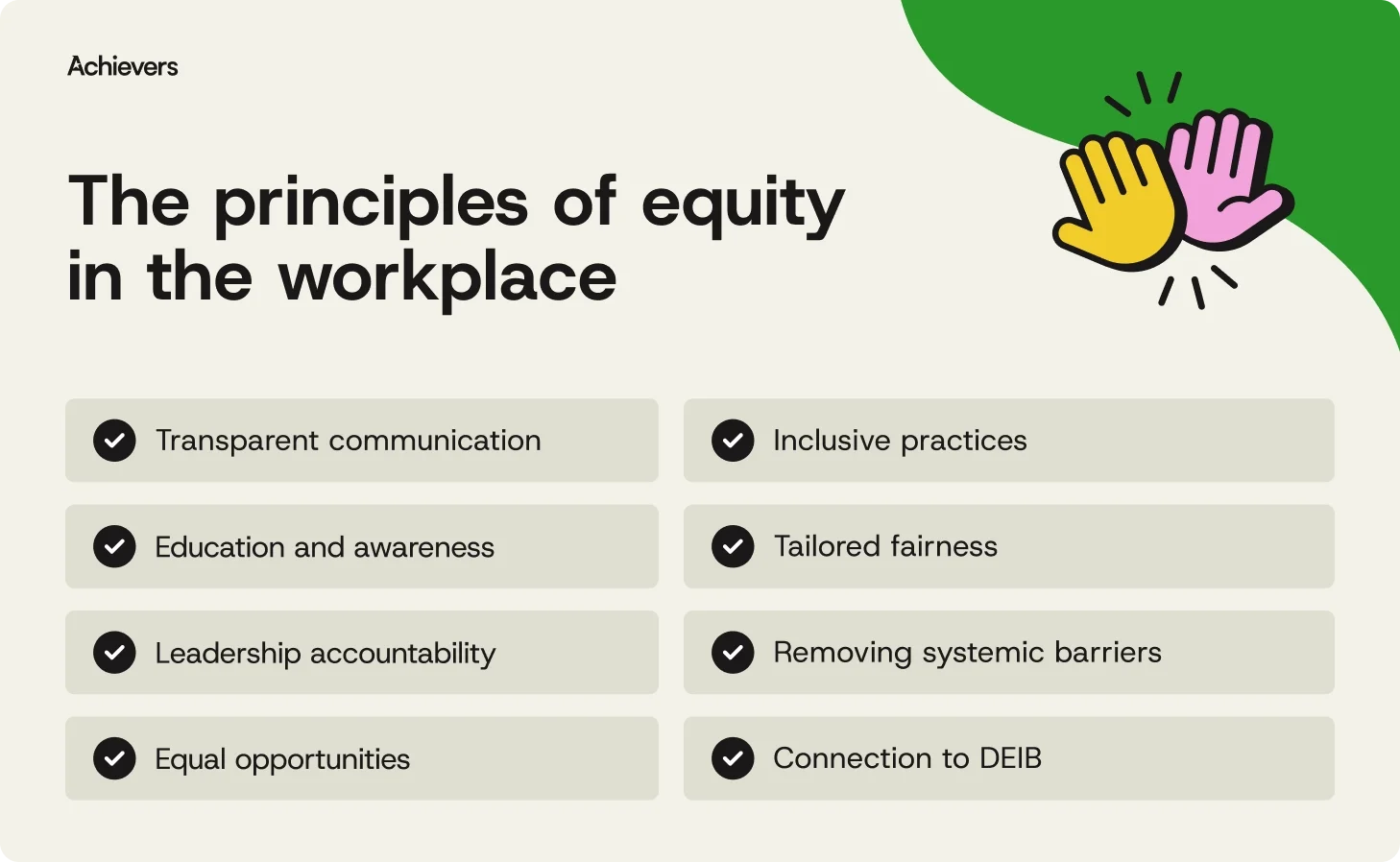Table of contents
Create a culture that means business™
Schedule a demo with an Achievers solution expert today.
Workplace equity shouldn’t be an aspiration — it should be the norm. Everyone deserves fair access to opportunity, recognition, and a real sense of belonging. But the numbers? They’re still catching up. As of 2024, women hold just 29% of executive roles in S&P 100 companies — and only 9% of CEO positions.
That’s not just a pipeline problem. It’s a culture problem. Equity can’t live in a mission statement — it has to show up in the moments that matter: who gets recognized, who gets promoted, and who feels like they truly belong. When it’s consistent, inclusive, and tied to impact, recognition becomes a culture-shaping force that helps close equity gaps and drive results where they matter most.
So, what does equity in the workplace really mean — and how can organizations make it real? Let’s break it down.
What is equity in the workplace?
Workplace equity means making sure every employee has fair access to opportunities, resources, and recognition — so they can fully contribute and grow. It’s not about treating everyone the same; it’s about removing systemic barriers, addressing individual needs, and creating a culture where success feels possible for everyone, not just a select few.
Why is equity important in the workplace?
Fairness shouldn’t feel like a bonus. When people trust that they’ll be heard, recognized, and given a real chance to grow, they’re more likely to stay engaged — and show up with purpose.
Here’s what happens when equity is part of the everyday:
- Higher engagement: When employees feel genuinely supported, engagement goes up — along with energy, purpose, and maybe even job satisfaction.
- Stronger collaboration: Equitable workplaces make space for more voices, which means more collaboration, better decisions, and less side-eye.
- Better performance: When people have the right tools and support (not just the same ones), they’re set up to succeed — and they do.
- Talent attraction: A culture built on fairness and belonging doesn’t just retain talent — it attracts it. Insights from the 2024 Engagement and Retention Report tell us that 72% of employees would take support and value over a 30% raise (Translation: belonging > bigger paycheck.)
- Healthier workplaces: Equity supports more than performance. It supports people — and that’s what builds a company culture worth staying for.
What are the principles of equity in the workplace?
Equity can’t be solved with a single policy or training session — it has to be part of how your culture works every day. That means looking beyond surface-level commitments and focusing on the principles that really shape employee experience.

Here’s what that looks like in practice:
- Transparent communication: Trust grows when people understand how decisions are made — not through whispers, but through clear, open dialogue.
- Education and awareness: Building equity starts with seeing the gaps. Ongoing education, bias training, and honest conversations help people become part of the solution.
- Leadership accountability: Equity needs action, not slogans. Leaders should set goals, track progress, and stay connected through tools that surface real-time feedback and recognition.
- Equal opportunities: Everyone deserves a fair shot at growth and leadership. People who see promotion equity in their workplace are more than twice as likely to say they can see themselves having a long career at the company.
- Inclusive practices: Equity should show up in every touchpoint — from hiring to performance reviews and frequent recognition. It’s not a side program; it’s how you operate.
- Tailored fairness: Equity isn’t about treating everyone the same — it’s about giving people what they need to succeed. That might look different for each person, and that’s the point.
- Removing systemic barriers: Equity means tackling the systems that quietly hold people back — from biased job descriptions to one-size-fits-all policies — and doing the work to break them down.
- Connection to DEIB: Equity is what turns good intentions into real outcomes by making sure everyone has the tools, support, and recognition they need to thrive.
Strategies to promote equity at work
Equity doesn’t fall into place just because you say it matters — it takes real work, every single day. It shows up in how you hire, how you champion your people, and how you build a culture where everyone feels like they belong (not just the ones who’ve figured out how to “fit in”).
Here are some people-first strategies to help turn equity into everyday action:
- Diversity mentorship programs: Connect senior leaders with employees from underrepresented groups to support growth and break down career roadblocks. It’s about access, visibility, and opening doors that have been closed for too long.
- Employee Resource Groups (ERGs): ERGs give employees a place to connect, share, and advocate. But they’re more than social groups — they can influence policy, shape culture, and build real community.
- Diversity training: Forget the one-and-done workshops. Meaningful DEIB training should spark self-awareness, challenge assumptions, and give people the tools to lead more inclusively at every level.
- Celebrate cultural holidays: Inclusion shows up in the details. Recognizing cultural and religious holidays — and giving people the space to celebrate them — is a small act that sends a big message: you belong here.
- Promote accessibility: If people can’t fully participate, they can’t fully belong. Make sure your spaces — physical and digital — work for everyone, whether that means screen readers, ramps, or simply more thoughtful design.
- Examine onboarding: Onboarding is your culture’s first impression. Make sure it’s welcoming, inclusive, and doesn’t assume everyone comes in knowing the unspoken rules of the office.
- Update hiring practices: Using clear criteria, diverse panels, and consistent interviews helps reduce bias — and keeps the playing field level. Don’t wait for problems to show up before reviewing your process. Check in often to make sure it’s still working for everyone.
- Recognize unconscious bias: Bias isn’t always loud, but it’s always there. Help your people name it, check it, and move toward more objective, fair decisions — especially when it comes to hiring and promotions.
- Promote DEIB from the top: If leadership isn’t backing DEIB, it’s just lip service. Make equity a leadership priority by setting goals, tracking progress, and celebrating wins along the way.
Why recognition belongs in your workplace equity strategy
Equity isn’t just about who moves up — it’s about whose work gets noticed, whose voice gets heard, and who feels like they truly matter. Recognition plays a big part in that.
When it’s done well, recognition makes impact visible — not just for the loudest voices, but for everyone contributing in meaningful ways. It helps level the playing field and reinforces the idea that everyone belongs.
Recognition programs like Achievers make appreciation feel natural — not forced. They fit right into the tools your team already uses, offer rewards people actually want, and even help avoid the awkward “good job!” emails. And when recognition feels authentic — not automated — it does what it’s meant to do: make people feel like their work matters.
How to measure equity in the workplace
If equity is going to be more than a buzzword, you need a way to measure it. That means going beyond gut checks and looking at the data behind your decisions — who’s getting hired, promoted, paid, and supported.
Here’s where to start:
- Look at pay equity: Break down compensation data across roles, experience levels, and demographics. People doing similar work should be paid fairly — no exceptions, no surprises.
- Track promotion rates: Take a close look at who’s moving up. If certain groups are consistently underrepresented in leadership, it’s a sign your advancement pathways need rethinking.
- Run feedback surveys: Ask employees how they’re experiencing your culture. Do they feel included? Valued? Do they believe they have a fair shot at growth? The answers offer insight you won’t get from spreadsheets alone.
- Audit your hiring practices: Check if your recruitment process is welcoming to a wide range of candidates — not just on paper, but in experience. Look at who’s applying, who’s advancing, and who’s getting offers.
- Analyze recognition patterns: Recognition data offers a unique lens into equity. Are certain teams or demographics being recognized more often — or not at all? Are you using a recognition platform to help uncover those trends so you can close visibility gaps before they turn into retention issues?
- Use insights to spot trends early: Tools like Achievers help uncover equity gaps through real-time recognition and engagement data — making it easier for leaders to respond with intention, not guesswork.
- Review and act on the data: Equity isn’t “set it and forget it.” Track trends over time, share the results openly, and use them to guide smarter, more inclusive decisions.
Turn equity into action with Achievers
Let’s be honest — equity doesn’t come from a one-time training, or a values slide buried in your onboarding deck. It’s built in the everyday: in who gets recognized, who gets heard, and who gets a real shot at growth.
It’s also messy sometimes. You won’t always get it right. But when you’re listening often, recognizing fairly, and checking your blind spots with intention (and a little humility), you’re moving in the right direction.
The goal isn’t to be perfect. It’s to be better — more aware, more inclusive, more human. That’s what turns equity from a line in your mission statement to something your people feel; not just during onboarding but on that random Tuesday afternoon.
And that’s exactly the kind of culture Achievers help companies build — one recognition, one insight, one intentional moment at a time.


